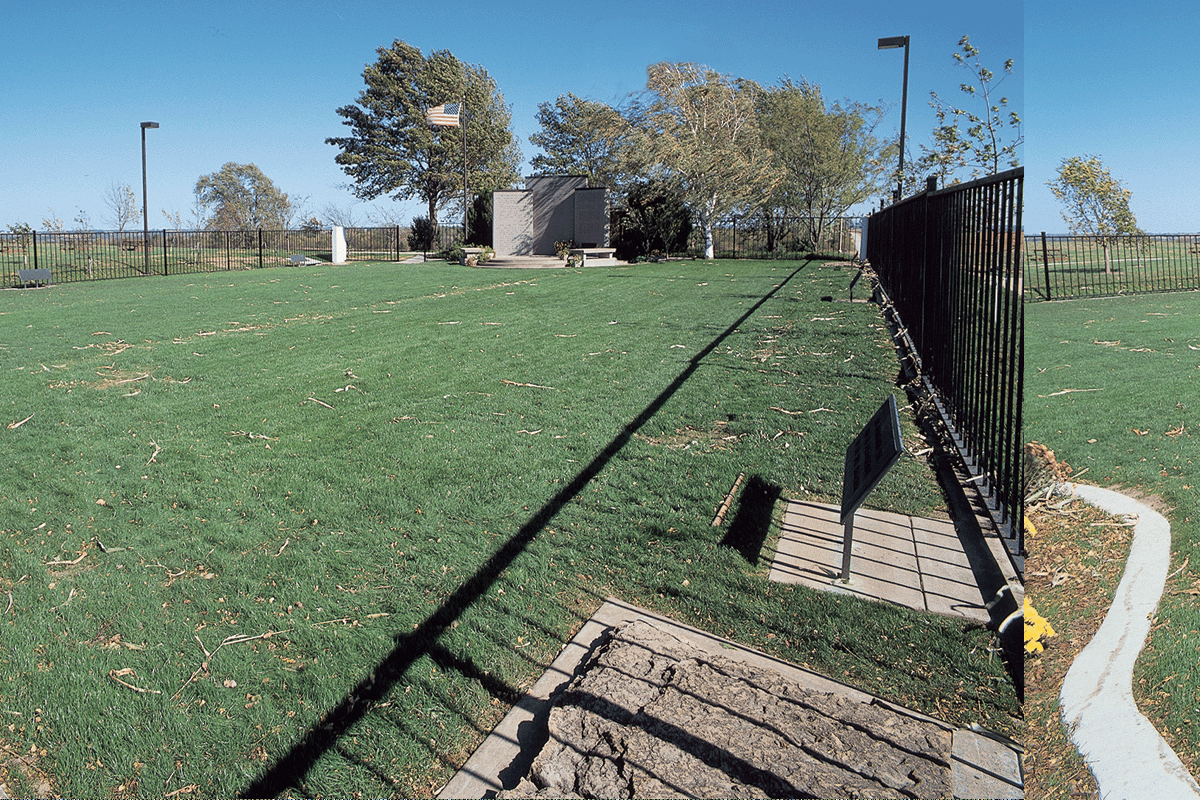I happen to be cruising around the LDS Temple website the other day and I was looking at the Temples under construction. I was wondering whether we the Church had announced a Temple and not built it. I knew that this happened, so I thought it might make an interesting post. Most of my information comes from that website, except where noted.
Independence Temple

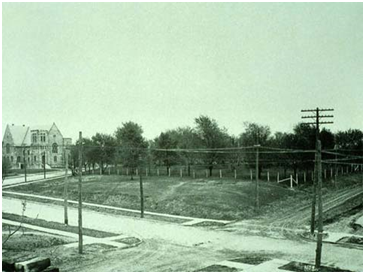 The site of the Independence Temple, or Temple Lot, is located southwest of the intersection of Lexington Street and River Boulevard in Independence, Missouri. On site is the headquarters of the Church of Christ. East and south of the Temple Lot are the Community of Christ (former Reorganized Church of Jesus Christ of Latter Day Saints) Temple and Auditorium, respectively. And southest of the Temple Lot on Walnut Street is the visitors’ center of The Church of Jesus Christ of Latter-day Saints. Also on Walnut are the Missouri Independence Mission office and the Independence Missouri Stake Center.
The site of the Independence Temple, or Temple Lot, is located southwest of the intersection of Lexington Street and River Boulevard in Independence, Missouri. On site is the headquarters of the Church of Christ. East and south of the Temple Lot are the Community of Christ (former Reorganized Church of Jesus Christ of Latter Day Saints) Temple and Auditorium, respectively. And southest of the Temple Lot on Walnut Street is the visitors’ center of The Church of Jesus Christ of Latter-day Saints. Also on Walnut are the Missouri Independence Mission office and the Independence Missouri Stake Center.
From the official founding of the Church in 1830 and throughout the next decade, Joseph Smith received several revelations that dealt with the location and building of a temple in Independence, Jackson County, Missouri. On 20 July 1831, the Lord said to Joseph, “Behold, the place which is now called Independence is the center place; and a spot for the temple is lying westward, upon a lot which is not far from the courthouse” (D&C 57:3). Sidney Rigdon was commanded to consecrate and dedicate the spot (D&C 58:57). Later, the Lord confirmed his command “that a house should be built unto me in the land of Zion, like unto the pattern which I have given you.” The revelation further stated that the temple was to be built by “tithing and sacrifice.” (D&C 97:10-12.) Richard Neitzel Holzapfel, T. Jeffery Cottle, “Window to the Past: A Photographic Panorama of Early Church History and the Doctrine and Covenants”
“On the third day of August, I proceeded to dedicate the spot for the Temple, a little west of Independence, and there were also present Sidney Rigdon, Edward Partridge, W. W. Phelps, Oliver Cowdery, Martin Harris, Joseph Coe and Newel Knight. The 87th Psalm was read. The scene was solemn and impressive.” D. H. C., Vol. 1:199.
While excavating for the foundation of a temple in 1929, the Church of Christ discovered the northeast and southeast cornerstone markers. The Great Depression set in shortly thereafter, and the temple was never built, but the stones are now on display in the Church’s visitors’ center room.
The Saints were expelled from Jackson County in late 1834, before they could make any progress on the temple. Despite their best efforts, they were unable to return to reclaim their lands. After they settled in Nauvoo, Illinois, Joseph recorded another revelation rescinding the earlier commandment to build the Independence temple:
” Verily, verily, I say unto you, that when I give a commandment to any of the sons of men to do a work unto my name, and those sons of men go with all their might and with all they have to perform that work, and cease not their diligence, and their enemies come upon them and hinder them from performing that work, behold, it behooveth me to require that work no more at the hands of those sons of men, but to accept of their offerings…. Therefore, for this cause have I accepted the offerings of those whom I commanded to build up a city and a house unto my name, in Jackson county, Missouri, and were hindered by their enemies, saith the Lord your God. (D&C 124:49, 51) http://en.fairmormon.org/Independence_temple_to_be_built_%22in_this_generation%22)
Prior to the Second Coming of Jesus Christ, a magnificent edifice-the New Jerusalem Temple-will be erected on the location of the Temple Lot.
Announcement: 26 April 1838
Groundbreaking: 3 July 1837
Site Dedication: 4 July 1838 by Brigham Young
The Far West Temple was the second temple commenced but never constructed by the early Saints in Missouri. The Far West Temple site is located in Caldwell County, which was created specifically as a settlement for the Saints, who had been driven out of Jackson County several years earlier in 1833. Far West was the county seat. See D&C 115.
“Let the city, Far West, be a holy and consecrated land unto me; and it shall be called most holy, for the ground upon which thou standest is holy. Therefore, I command you to build a house unto me, for the gathering together of my saints, that they may worship me.” (D&C 115:7-8)
The cornerstones were laid for the Far West Temple on July 4, 1838, in the following order: southeast by the Stake presidency, southwest by the Elder’s quorum presidency, northwest by the Bishop, and northeast by the Teacher’s quorum presidency. At the cornerstone laying for the Far West Temple, President Sidney Rigdon gave his famous Independence Day oration. The speech’s passionate declarations fueled tension between the Saints and the citizens of Missouri, eventually culminating in the issuance of Governor Lilburn W. Boggs’ extermination order on October 27, 1838.
Despite the great risk of danger, five apostles-accompanied by several others-returned to the Far West Temple site just after midnight on the morning of April 26, 1839, in fulfillment of prophecy. A large stone was rolled on the southeast cornerstone as recommencement of work on the foundation, and the apostles left to prepare for their overseas missions.
The Far West Temple site was reacquired by the LDS Church in 1909 under the direction of Joseph F. Smith.
Adam-ondi-Ahman Temple
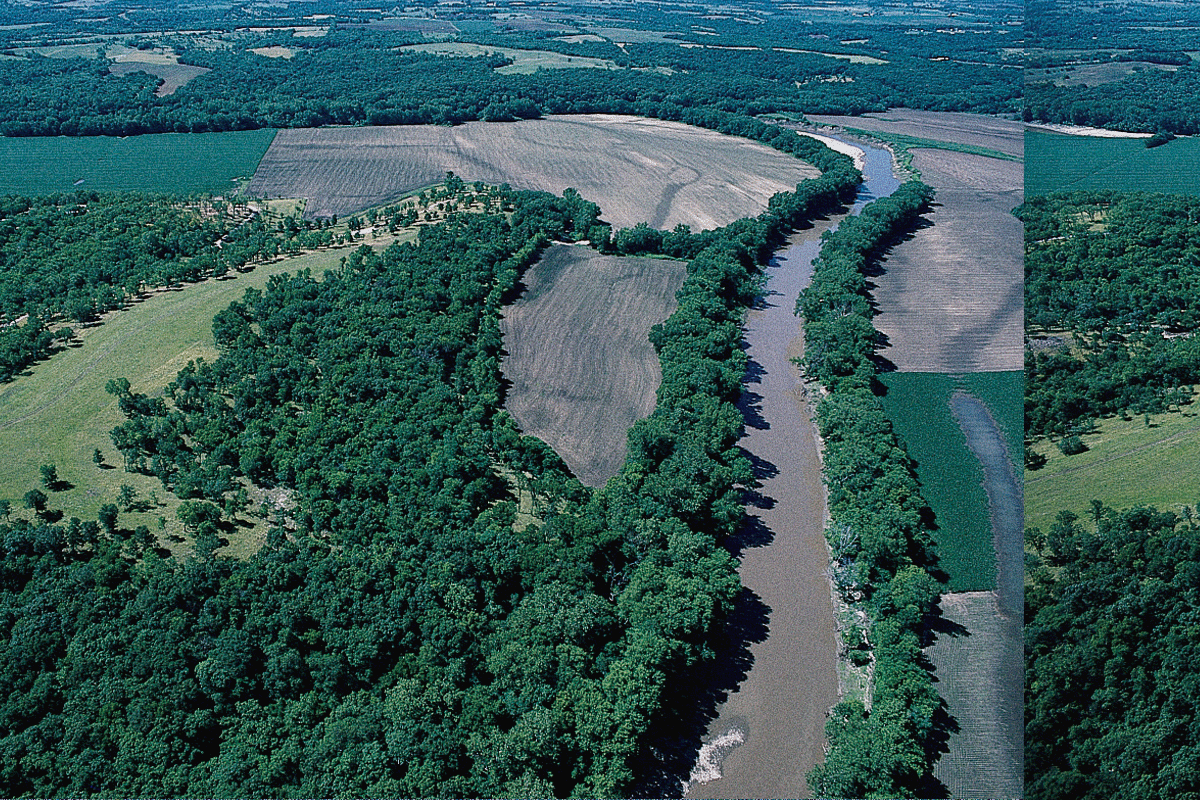 Site Dedication: October 1838 by Brigham Young
Site Dedication: October 1838 by Brigham Young
The beautiful site of Adam-ondi-Ahman lies at a bend in the Grand River in northern Missouri, about 70 miles north of Kansas City. On the highest elevation of Spring Hill, 124 feet above Grand River, a temple block was dedicated. No cornerstones were laid or temple constructed, however, as just days later, the Saints were ordered to leave the settlement. The Church has since acquired the site and much of the surrounding area, which is leased to local farmers.
The Adam-ondi-Ahman Temple was the third temple planned but never constructed by the early Saints in Missouri. The name Adam-ondi-Ahman is an English rendition of a phrase from the pure Adamic language, which could possibly mean “Adam in the presence of God.”The valley of Adam-ondi-Ahman was revealed to Joseph Smith to be the place where Adam blessed his posterity after being driven from the Garden of Eden.The first settlers of Adam-ondi-Ahman arrived in February 1838. By November 1838, the Saints had been delivered an ultimatum to leave Daviess County within 10 days.
On June 11, 1838, Joseph Smith gave Spring Hill the name of Adam-ondi-Ahman. Some evidence suggests that a public square-not a temple block-was dedicated in October 1838 at Adam-ondi-Ahman.
Adam-ondi-Ahman is the site of a future grand council where Jesus Christ will meet with His stewards of all dispensations and receive back the keys of the kingdom in preparation for His Second Coming. Only those called to the meeting will know of its occurence.
Samoa Temple
Announcement: 15 October 1977
Suspended: 2 April 1980
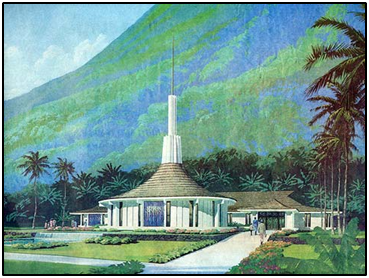 Steady growth of Church membership in the Pacific islands prompted the 1977 First Presidency announcement of a regional temple to serve the 50,000 saints scattered across the islands of Samoa, Tonga, French Polynesia (Tahiti), and Fiji. At the time, members had to cross the Pacific Ocean for hundreds of miles to attend services in the Hamilton New Zealand Temple. The Tahitian saints, who lived the farthest from the temple, devotedly traveled 2,500 miles to receive temple blessings.
Steady growth of Church membership in the Pacific islands prompted the 1977 First Presidency announcement of a regional temple to serve the 50,000 saints scattered across the islands of Samoa, Tonga, French Polynesia (Tahiti), and Fiji. At the time, members had to cross the Pacific Ocean for hundreds of miles to attend services in the Hamilton New Zealand Temple. The Tahitian saints, who lived the farthest from the temple, devotedly traveled 2,500 miles to receive temple blessings.
A groundbreaking ceremony was anticipated to take place in late 1978 with completion of the temple in 1980.
The specific site chosen for the Samoa Temple was in Malaeimi Valley on Tutila Island near the village of Pago Pago, American Samoa, adjacent to a newly completed stake center. Its location on a bus-serviced road from the international airport made it easily accessible to the many members who would be traveling to the temple by air. The picturesque setting at the base of a lush natural hill-visible from the ocean-is covered with beautiful foliage and palms trees.
Church architect Emil B. Fetzer said, “We expect [the temple] to be one of the finest, if not the finest, building on the island as far as workmanship, design and materials are concerned.” Plans called for a 20,000-square-foot temple, which would house a baptistry, a 100-seat ordinance room, four sealing rooms, and a circular Celestial Room featuring stained glass (visible from the front of the temple) and crowned by a round roof and single spire. The grounds would be extensively landscaped and feature a water fountain and reflecting pool.
On April 2, 1980, a landmark announcement by the First Presidency of plans for seven new temples for seven different nations were accompanied by a location and design change for the Samoa Temple. At a press conference, President Spencer W. Kimball said, “The Pago Pago location was selected on the basis of convenience for air travelers from other islands. Since there will be two other temples in the South Pacific islands, the Samoa site was altered to be more convenient to Samoan members. Its design will also conform to those included in this announcement.” With additional announcements for Nuku’alofa, Tonga and Papeete, Tahiti, the location of the Samoa Temple was moved from Pago Pago, American Samoa, to Apia, Samoa. The design and size were altered to conform to a new 12,500-square-foot standard design. The location change placed the temple on the island where the vast majority of Samoan members reside.
Hartford Connecticut Temple
Announcement: 3 October 1992
Suspended: 30 September 1995
During the Saturday afternoon session of General Conference on October 3, 1992, President Gordon B. Hinckley, First Counselor in the First Presidency, announced plans for a regional temple to be built in Hartford, Connecticut, to serve members in the New York and New England areas of the United States. Plans were also announced for the Hong Kong China Temple to serve a large region of Southeastern Asia and a second temple for Utah County to relieve the overburdened Provo Utah Temple-later identified as the Mount Timpanogos Utah Temple.
Three years after the announcement, plans for the Hartford Connecticut Temple were replaced. President Gordon B. Hinckley explained in the priesthood session of General Conference, “After working for years to acquire a suitable site in the Hartford area, during which time the Church has grown appreciably in areas to the north and south, we have determined that we will not at this time build a temple in the immediate area of Hartford.” Plans were then announced for temples in Boston, Massachusetts, and White Plains, New York. “In other words,” he said, “there will be two [temples] to serve the needs of the people where originally it was planned that one would do. We have sites in both of these new locations.”
To the members of Hartford who had joyed in the announcement of this temple, Pres. Hinckley said, “We apologize to our faithful Saints in the Hartford area. We know you will be disappointed in this announcement. You know that we, and your local officers, have spent countless hours searching for a suitable location that would handle the needs of the Saints in New York and New England. While we deeply regret disappointing the people in the Hartford area, we are satisfied that we have been led to the present decision, and that temples will be located in such areas that our Saints in the Hartford area will not have to drive unreasonable distances.”
Harrison New York Temple
Announcement: 30 September 1995
Suspended: Mid-2000s, following the dedication of the Manhattan New York Temple (2004)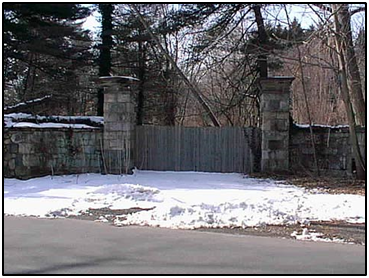
On September 30, 1995, during the priesthood session of General Conference, President Gordon B. Hinckley announced that plans for a regional temple in Hartford, Connecticut, which would serve the New York and New England areas of the United States, had been replaced with plans for two temples for that region on sites in Boston, Massachusetts, and White Plains, New York-later designated Harrison, New York. “In other words,” said Pres. Hinckley, “there will be two [temples] to serve the needs of the people where originally it was planned that one would do.”
On March 8, 1996, the Church purchased a beautifully wooded 24-acre site for the temple at the highly accessible intersection of Interstate 287 and Hutchinson River Parkway. The location of the site in Harrison was reflected in a name change made during a major renaming of many of the Church’s temples to a uniform guideline in October 1999, making the White Plains New York Temple the Harrison New York Temple.
The residents of Harrison and the Town Planning Board were very much opposed to the Church building its Temple in their town. As a result, the Church scaled back plans for 89,000 Sq foot building to a 56,000 Sq Ft. in an effort to appease certain elements in the town. They reduced the height of the steeple from 159 ft to 115 ft. and finally to 44 feet. They applied for a variance from the town, which had a 30 ft limit. That variance was denied. The Church elected to pursue a lawsuit, accusing the town of infringing on freedom of religion and assembly.
The spirit of compromise filled members of the Harrison Town Board, who unanimously voted on April 30, 2002, to approve a proposed settlement with the Church, when it became clear that the town would likely lose in court and spend millions of dollars if legal action were pursued. The agreement resulted in numerous additional concessions by the Church including reducing the building from 56,000 square feet to 28,400 square feet, dropping the number of seats from 200 to 100, lowering the height of the building from 44.7 feet to 34 feet and steeple from 115 feet to 105 feet, trimming the number of parking spaces from 198 to 135, paying for any damage to Kenilworth Road caused by construction, and refraining from building anything else on the property for 15 years after the temple opens.
In August 2002, the Church announced its plans to build the Manhattan New York Temple inside an existing Church-owned building. Though the seven-year dispute in Harrison contributed to the decision, significant membership growth in the city was emphasized, as explained by Stake President Brent Belnap: “Growth in the five boroughs has been so great, that the logic of having a temple within easy access to public transportation in the heart of the city makes far more eminent sense.”
By 2006, the Harrison New York Temple was removed from the Church’s official list of announced temples. The decision to build a temple on this site would constitute a new announcement.
Paris France Temple
Proposed: 4 June 1998 by Gordon B. Hinckley
During a European tour to dedicate the Preston England Temple, President Gordon B. Hinckley met with about 2,400 members from two Paris stakes and three outlying districts. In his remarks, he noted, “When I came here after the war, there were so few members of the Church, and now there are 30,000 of you.” He continued, “I don’t want to build up your hopes, but the time has come when you deserve to have a temple among you, and we’ll look for a place to build one. I don’t know how long it will take to find a suitable site. I invite every one of you, my brethren and sisters, to plead with the Lord individually in your prayers to lead us to a property in this great city, or its environs, where we can build a house of the Lord so that you won’t have to travel five hours to Frankfurt or six hours to Zollikofen. Please unite your prayers with ours, and the time will come, and I hope that it will be quick in coming, when we can construct somewhere in this area a house of the Lord, a sacred temple, into which you can go and do that work which is found only in the temples of the Lord.”
In May 2004, President Hinckley returned to Paris, shortly after the dedication of the Copenhagen Denmark Temple. He met with French members on May 28 in a hotel convention hall on the property of Euro Disney. Remarking on the upcoming dedication of the Manhattan New York Temple, President Hinckley expressed, “I wish I could announce that we could have a temple here, but we do not have a suitable place yet, in my judgment, to build it. And so, we will continue to look. I don’t know when it will be built, but I am confident that we will have a temple for the French-speaking people of the Church sometime in the future.” Continuing he said, “You are worthy of the richest blessings of the Church. You are worthy of every blessing which this Church has to offer. And there is no blessing greater than the blessing of the house of the Lord. And so, my brothers and sisters, I ask you to be patient for a time. I know it is a long way to Frankfurt where you go. I hope that you will continue to go there, but sometime in the future a beautiful house of the Lord will grace this land.”
As the April 2006 General Conference approached, hopes rose that the Paris France Temple would be announced when French media disclosed the Church’s interest in purchasing a huge tract of land outside Versailles-about one-third of the small city of Villepreux-reportedly for a temple. A church spokesman confirmed the Church was working with the property owners, but he said that the use of the property had not been determined and that temple locations were announced by the First Presidency. The summer before, President Hinckley had been considering a parcel of land in Saint-Cloud, a suburb of Paris, but attention had now turned to the Villepreux property. Moulin Rouge owners, the Clerico family, were also the owners of the land. Of the three interested parties-an Arab emirate, a Russian, and the Mormons-the mayor of Villepreux said he preferred the Mormons for two reasons: morality and quality of investment. Never has there been any concern about public order with church members, he said.3 No temple announcement was made, however, and in the end, the Church did not succeed in acquiring the property.
Southwest Salt Lake Valley Temple
Proposed: 1 October 2005 by Gordon B. Hinckley
During the opening session of the October 2005 General Conference, President Gordon B. Hinckley announced the construction of a temple in South Jordan, Utah, later named the Oquirrh Mountain Utah Temple. With this announcement, President Hinckley indicated that another temple site had been acquired in the southwest part of the Salt Lake Valley, which would be announced later once membership growth in the valley required it.

